Jaipur
Elefantastic
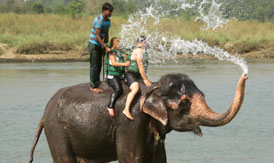 Elefantastic Elephant Farm is India’s first elephant farm designed in Jaipur and is technically the most unique experience to be up close & personal with Asian elephants. It was started on 21st February 2012 by an elephant rider with a single vision to answer questions about Indian elephants, their relationship with humans and also to give a fantastic experience to India travellers.
This unique experience in India begins by letting you stroke the elephants, look into their eyes, practice the elephant language with the mahouts (care-takers), feed them sugar-cane, give them water to drink and form the beginnings of a life-long relationship. Afterwards, you’ll be encouraged to help paint them using natural materials, a traditional Rajasthani activity that looks amazing. Post painting your name & design, you'll get to wash up your elephant through a water hose in winter or head for the lake in summer. Some of the other highlights include s troke and play with elephants, bare-back elephant ride, h elp with feeding and bath-time, p aint the elephants, and learn to speak to them.
Elefantastic Elephant Farm is India’s first elephant farm designed in Jaipur and is technically the most unique experience to be up close & personal with Asian elephants. It was started on 21st February 2012 by an elephant rider with a single vision to answer questions about Indian elephants, their relationship with humans and also to give a fantastic experience to India travellers.
This unique experience in India begins by letting you stroke the elephants, look into their eyes, practice the elephant language with the mahouts (care-takers), feed them sugar-cane, give them water to drink and form the beginnings of a life-long relationship. Afterwards, you’ll be encouraged to help paint them using natural materials, a traditional Rajasthani activity that looks amazing. Post painting your name & design, you'll get to wash up your elephant through a water hose in winter or head for the lake in summer. Some of the other highlights include s troke and play with elephants, bare-back elephant ride, h elp with feeding and bath-time, p aint the elephants, and learn to speak to them.
Amber Fort
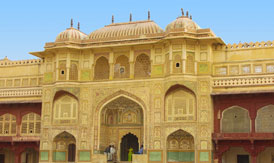 The Amer Fort, situated in Amber, 11 kilometers from Jaipur, is one of the most famous forts of Rajasthan. Amer, originally, was the capital of the state before Jaipur. It is an old fort, built in 1592 by Raja Man Singh. This fort is also very popularly known as the Amer Palace. The Amer Fort was built in red sandstone and marble and the Maotha Lake adds a certain charm to the entire Fort. Though the fort is quite old and may even look so from the outside, it is beautiful on the inside and boasts of various buildings of prominence like the 'Diwan-i-Aam', the 'Sheesh Mahal' and even the 'Sukh Mahal'. The Amer Fort has influences of both Hindu and Muslim architecture. This fort also has the 'Shila Devi' Temple and the 'Ganesh Pol' which is a gate that leads to the private palaces of the kings. The Amer Fort has many pavilions and halls of great interest and other popular attractions.
The Amer Fort, situated in Amber, 11 kilometers from Jaipur, is one of the most famous forts of Rajasthan. Amer, originally, was the capital of the state before Jaipur. It is an old fort, built in 1592 by Raja Man Singh. This fort is also very popularly known as the Amer Palace. The Amer Fort was built in red sandstone and marble and the Maotha Lake adds a certain charm to the entire Fort. Though the fort is quite old and may even look so from the outside, it is beautiful on the inside and boasts of various buildings of prominence like the 'Diwan-i-Aam', the 'Sheesh Mahal' and even the 'Sukh Mahal'. The Amer Fort has influences of both Hindu and Muslim architecture. This fort also has the 'Shila Devi' Temple and the 'Ganesh Pol' which is a gate that leads to the private palaces of the kings. The Amer Fort has many pavilions and halls of great interest and other popular attractions.
Sheesh Mahal
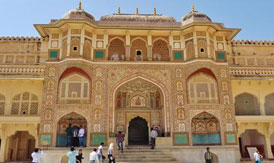 Sheesh mahal and also known as mirror palace is the magnificent piece of architecture built with beautiful precious stones and glass and with beautiful handmade paintings. Sheesh mahal is the most popular and beautiful part of Amer Fort. It is situated in Amer, Jaipur. This palace was built by king Man Singh in 16th century and completed in 1727. It is also the foundation year of jaipur state. This palace is also known for the bollywood legendary movie "Mughal-e-Azam" iconic song "Jab pyar kiya to darna kya". It was shot in Sheesh Mahal on legendary actress Madhubala which played the role of "Anarkali" in the movie. And the combo of both "Sheesh mahal" and Madhubala came out excellent and rest was history. The wall and ceiling of the hall is carved with beautiful paintings and flowers which was made of pure glass and precious stone. And the placement of ceiling glass is wonderful. Because of this if someone burns two candles, then the reflection converts that small light into thousand of stars and it looks awesome and by this you can get the idea of what was the level of architecture in that time in India.
Sheesh mahal and also known as mirror palace is the magnificent piece of architecture built with beautiful precious stones and glass and with beautiful handmade paintings. Sheesh mahal is the most popular and beautiful part of Amer Fort. It is situated in Amer, Jaipur. This palace was built by king Man Singh in 16th century and completed in 1727. It is also the foundation year of jaipur state. This palace is also known for the bollywood legendary movie "Mughal-e-Azam" iconic song "Jab pyar kiya to darna kya". It was shot in Sheesh Mahal on legendary actress Madhubala which played the role of "Anarkali" in the movie. And the combo of both "Sheesh mahal" and Madhubala came out excellent and rest was history. The wall and ceiling of the hall is carved with beautiful paintings and flowers which was made of pure glass and precious stone. And the placement of ceiling glass is wonderful. Because of this if someone burns two candles, then the reflection converts that small light into thousand of stars and it looks awesome and by this you can get the idea of what was the level of architecture in that time in India.
Jantar Mantar
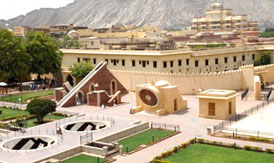 There are plenty of observatories all over the world, but the Jantar Mantar is considered to be one of the largest observatories ever built. Combining religion, science and art, the Jantar Mantar is the name given to a series of five, magnificent structures built in Jaipur, New Delhi, Ujjan, Varanasi and Mathura. Jaipur was the seat of Maharaja Jai Singh II during the 1720's and this is when this magnificent structure was built here. The Jantar Mantar in Jaipur is considered to be the largest of the five observatories and also houses the world's largest sundial. The Universe and the Cosmos have always been of interest to man, and it was this interest that compelled the Maharaja to build an astronomical observatory. The term 'Jantar Mantar' is derived from the Sanskrit terms 'Yantra' and 'Mantra' meaning 'instruments' and 'formula' respectively. The term 'Yantra' was replaced with 'Jantar' which means 'magical'. The Jantar Mantar houses various architectural and astrological instruments that have caught the interests of astronomers, historians and architects around the world.
There are plenty of observatories all over the world, but the Jantar Mantar is considered to be one of the largest observatories ever built. Combining religion, science and art, the Jantar Mantar is the name given to a series of five, magnificent structures built in Jaipur, New Delhi, Ujjan, Varanasi and Mathura. Jaipur was the seat of Maharaja Jai Singh II during the 1720's and this is when this magnificent structure was built here. The Jantar Mantar in Jaipur is considered to be the largest of the five observatories and also houses the world's largest sundial. The Universe and the Cosmos have always been of interest to man, and it was this interest that compelled the Maharaja to build an astronomical observatory. The term 'Jantar Mantar' is derived from the Sanskrit terms 'Yantra' and 'Mantra' meaning 'instruments' and 'formula' respectively. The term 'Yantra' was replaced with 'Jantar' which means 'magical'. The Jantar Mantar houses various architectural and astrological instruments that have caught the interests of astronomers, historians and architects around the world.
Govind Devji Temple
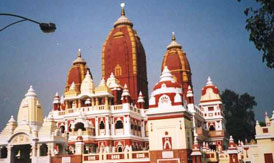 The temple of Govind Dev Ji is one of the most sacred and famous tourist destinations in India. It is located in the City Palace complex, in Jaipur, Rajasthan. The deity, Govind Dev Ji, is none other than Lord Shri Krishna himself. It is believed that the image in this temple looks exactly how Lord Krishna looked during his incarnation on earth. The idol was originally kept in the temple of Vrindavan in Uttar Pradesh and was later brought to Jaipur by Raja Sawai Jai Singh, a staunch devotee of Lord Krishna. The idol of Govind Dev Ji is strikingly beautiful for its complete resemblance with Lord Krishna, and the temple is placed between Chandra Mahal and Badal Mahal in the City Palace complex. Every day, various 'Aartis' and 'Prasad' or 'Bhogs' are offered at the temple, at seven different times. The festival of Janmashtami is among the most important ones celebrated here as it commemorates the birth of Lord Krishna.
The temple of Govind Dev Ji is one of the most sacred and famous tourist destinations in India. It is located in the City Palace complex, in Jaipur, Rajasthan. The deity, Govind Dev Ji, is none other than Lord Shri Krishna himself. It is believed that the image in this temple looks exactly how Lord Krishna looked during his incarnation on earth. The idol was originally kept in the temple of Vrindavan in Uttar Pradesh and was later brought to Jaipur by Raja Sawai Jai Singh, a staunch devotee of Lord Krishna. The idol of Govind Dev Ji is strikingly beautiful for its complete resemblance with Lord Krishna, and the temple is placed between Chandra Mahal and Badal Mahal in the City Palace complex. Every day, various 'Aartis' and 'Prasad' or 'Bhogs' are offered at the temple, at seven different times. The festival of Janmashtami is among the most important ones celebrated here as it commemorates the birth of Lord Krishna.
Birla Mandir Temple
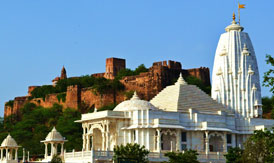 The Birla Temple, originally known as Lakshmi Narayan Temple, and is situated below the Moti Dungri Fort in Jaipur. Dedicated to Lord Vishnu and Goddess Lakshmi, this temple is a proud architectural landmark of Jaipur. Built in pure white marble, the Birla Temple is unlike the traditional ancient Hindu temples, and is built with a modern approach. Inside this magnificent shrine, beautifully sculpted idols of Lord Vishnu and Goddess Lakshmi, as well as other Hindu Gods and Goddesses, can be seen. Delicate carvings of Hindu symbols, and ancient quotes from the Geeta and the Upanishads ornament the walls of this fascinating temple. One can also recognize the mythological events engraved on the walls. Apart from the religious idols, pictures and figures of several religious saints, philosophers and historical achievers, like Socrates, Buddha, Zarathustra and Confucius, are also included in the temple. A work of art, this temple truly represents architectural beauty, in a modern form.
The Birla Temple, originally known as Lakshmi Narayan Temple, and is situated below the Moti Dungri Fort in Jaipur. Dedicated to Lord Vishnu and Goddess Lakshmi, this temple is a proud architectural landmark of Jaipur. Built in pure white marble, the Birla Temple is unlike the traditional ancient Hindu temples, and is built with a modern approach. Inside this magnificent shrine, beautifully sculpted idols of Lord Vishnu and Goddess Lakshmi, as well as other Hindu Gods and Goddesses, can be seen. Delicate carvings of Hindu symbols, and ancient quotes from the Geeta and the Upanishads ornament the walls of this fascinating temple. One can also recognize the mythological events engraved on the walls. Apart from the religious idols, pictures and figures of several religious saints, philosophers and historical achievers, like Socrates, Buddha, Zarathustra and Confucius, are also included in the temple. A work of art, this temple truly represents architectural beauty, in a modern form.
Hawa Mahal
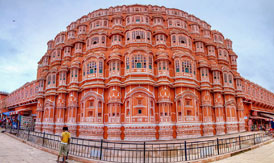 The renowned 'Palace Of The Winds', or Hawa Mahal, is one of the prominent tourist attractions in Jaipur city. Located in the heart of Jaipur, this beautiful five-storey palace was constructed in 1799 by Maharaja Sawai Pratap Singh who belonged to Kachhwaha Rajput dynasty. The main architect of this palace built of red and pink sandstone, is Lal Chand Ustad and the palace is believed to have been constructed in the form of the crown of Krishna, the Hindu god. Considered as an embodiment of Rajputana architecture, the main highlight of Hawa Mahal is its pyramid shape and its 953 windows or 'Jharokhas' which are decorated with intricate designs. The main intention behind the construction of the Mahal was to facilitate the royal women and provide them a view of everyday life through the windows, as they never appeared in public. Read further to know more about Hawa Mahal, its history, architecture and its visiting hours.
The renowned 'Palace Of The Winds', or Hawa Mahal, is one of the prominent tourist attractions in Jaipur city. Located in the heart of Jaipur, this beautiful five-storey palace was constructed in 1799 by Maharaja Sawai Pratap Singh who belonged to Kachhwaha Rajput dynasty. The main architect of this palace built of red and pink sandstone, is Lal Chand Ustad and the palace is believed to have been constructed in the form of the crown of Krishna, the Hindu god. Considered as an embodiment of Rajputana architecture, the main highlight of Hawa Mahal is its pyramid shape and its 953 windows or 'Jharokhas' which are decorated with intricate designs. The main intention behind the construction of the Mahal was to facilitate the royal women and provide them a view of everyday life through the windows, as they never appeared in public. Read further to know more about Hawa Mahal, its history, architecture and its visiting hours.
City Palace
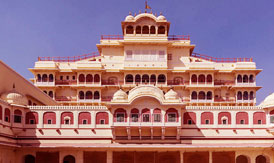 Located in the heart of the Pink City Jaipur, the City Palace was where the Maharaja reigned from. This palace also includes the famous 'Chandra Mahal' and 'Mubarak Mahal', and other buildings which form a part of the palace complex. The palace is located towards the northeast side of central Jaipur and has many courtyards and buildings. The palace was built between 1729 and 1732 AD by Sawai Jai Singh II. He ruled in Amer and planned and built the outer walls of the palace and later rulers added to the architecture of this palace. These additions have been known to take place right up to the 20th century. The urban layout of the city of Jaipur was commissioned to Vidyadhar Bhattacharya and Sir Samuel Swinton Jacob. The architectural styles are largely based on a fusion of Rajput, Mughal and European styles. Today, the 'Chandra Mahal' has been turned into a museum which is home to unique handcrafted products, various uniforms of the rulers and many more things pertaining to the royal heritage of the City Palace.
Located in the heart of the Pink City Jaipur, the City Palace was where the Maharaja reigned from. This palace also includes the famous 'Chandra Mahal' and 'Mubarak Mahal', and other buildings which form a part of the palace complex. The palace is located towards the northeast side of central Jaipur and has many courtyards and buildings. The palace was built between 1729 and 1732 AD by Sawai Jai Singh II. He ruled in Amer and planned and built the outer walls of the palace and later rulers added to the architecture of this palace. These additions have been known to take place right up to the 20th century. The urban layout of the city of Jaipur was commissioned to Vidyadhar Bhattacharya and Sir Samuel Swinton Jacob. The architectural styles are largely based on a fusion of Rajput, Mughal and European styles. Today, the 'Chandra Mahal' has been turned into a museum which is home to unique handcrafted products, various uniforms of the rulers and many more things pertaining to the royal heritage of the City Palace.
Amer Jeep Safari
 Every year, a great number of tourists, plan their vacation on the desert terra firm of Jaipur and its surroundings, and take pleasure in a range of safaris. Jeep safari (4x4 are really powerful machines customized into 4-wheels drive) is one of the most loved and exhilarating activities to experience around Jaipur. Jeep is the easiest way to discover the desert terra firm of Jaipur. The trill and enthusiasm of jeep safari, definitely offers travelers an unparalleled and a remarkable experience to travel by jeep. It is an amazing activity that you should never miss in your tour around Jaipur. Normally, the safari jeep tour, will take the tourist traveling in a range which remains untouched by modern influences. The guests will see an interesting and real Rajasthan but unknown by many. They can have an amazing chance to travel around the conventional villages, outstanding cities and scenery of vivid state. The jeep safari in the arid region of Rajasthan will hypnotize you in the attractive civilization of villages.
Every year, a great number of tourists, plan their vacation on the desert terra firm of Jaipur and its surroundings, and take pleasure in a range of safaris. Jeep safari (4x4 are really powerful machines customized into 4-wheels drive) is one of the most loved and exhilarating activities to experience around Jaipur. Jeep is the easiest way to discover the desert terra firm of Jaipur. The trill and enthusiasm of jeep safari, definitely offers travelers an unparalleled and a remarkable experience to travel by jeep. It is an amazing activity that you should never miss in your tour around Jaipur. Normally, the safari jeep tour, will take the tourist traveling in a range which remains untouched by modern influences. The guests will see an interesting and real Rajasthan but unknown by many. They can have an amazing chance to travel around the conventional villages, outstanding cities and scenery of vivid state. The jeep safari in the arid region of Rajasthan will hypnotize you in the attractive civilization of villages.
Moti Dungari Temple
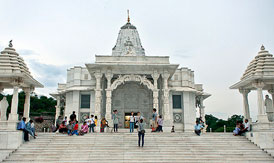 Moti Dungri is widely acclaimed for the architectural and spiritual point of view. Spanned over an area of nearly 2 kilometres Ganesha Temple in Moti Dungri is known for its pattern work on marbles that are engraved with legendary descriptions. This temple is perfect combination of Indian, Islamic as well as western representations which are characterized by its three domes. Being dedicated to Lord Ganesha, this temple is prominent for its scenic location and pictorial view that it lends to the visitors. People from almost every corner of the world visit here to dedicate their respect and offering to Lord Ganesha. According to legends, King of Mawali (Mewar) while returning from a long journey to his palace wished to establish a temple at the first halting point of his bullock cart that was carrying the huge idol of Lord Ganesha. His cart became resistive and stopped at the foot of the Moti Dungri hills which lead to setting up of Ganesha temple at this place.
Moti Dungri is widely acclaimed for the architectural and spiritual point of view. Spanned over an area of nearly 2 kilometres Ganesha Temple in Moti Dungri is known for its pattern work on marbles that are engraved with legendary descriptions. This temple is perfect combination of Indian, Islamic as well as western representations which are characterized by its three domes. Being dedicated to Lord Ganesha, this temple is prominent for its scenic location and pictorial view that it lends to the visitors. People from almost every corner of the world visit here to dedicate their respect and offering to Lord Ganesha. According to legends, King of Mawali (Mewar) while returning from a long journey to his palace wished to establish a temple at the first halting point of his bullock cart that was carrying the huge idol of Lord Ganesha. His cart became resistive and stopped at the foot of the Moti Dungri hills which lead to setting up of Ganesha temple at this place.
Jaigarh Fort
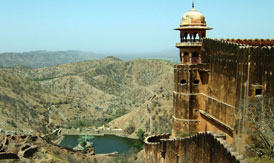 The Jaigarh Fort is a majestic stronghold built by Sawan Jai Singh II. This almost-intact fort is surrounded by huge battlements and is connected to the Amer Fort (also called 'Amber' Fort), with subterranean passages. Originally built to protect the Amer Fort and the palace within the complex, the Jaigarh Fort is architecturally similar to the Amer Fort, and offers a panoramic view of the city of Jaipur. The fort houses the world's largest cannon on wheels, a majestic palace complex and the assembly hall of the warriors known as 'Shubhat Niwas' along with a museum and an armory. Apart from the intricate architecture of the fort, the fort was also renowned for a huge treasure that was believed to be buried under the fort. It is now said that the government of Rajasthan seized the treasure when it was discovered in the 1970s. The Jaigarh Fort was built to secure Jaipur City and the Amer fort from warlords and rivals.
The Jaigarh Fort is a majestic stronghold built by Sawan Jai Singh II. This almost-intact fort is surrounded by huge battlements and is connected to the Amer Fort (also called 'Amber' Fort), with subterranean passages. Originally built to protect the Amer Fort and the palace within the complex, the Jaigarh Fort is architecturally similar to the Amer Fort, and offers a panoramic view of the city of Jaipur. The fort houses the world's largest cannon on wheels, a majestic palace complex and the assembly hall of the warriors known as 'Shubhat Niwas' along with a museum and an armory. Apart from the intricate architecture of the fort, the fort was also renowned for a huge treasure that was believed to be buried under the fort. It is now said that the government of Rajasthan seized the treasure when it was discovered in the 1970s. The Jaigarh Fort was built to secure Jaipur City and the Amer fort from warlords and rivals.
Nahargarh Fort
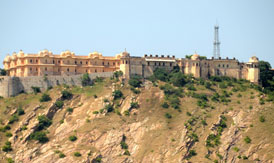 The Indian state of Rajasthan is famous for its royal heritage. Formed by the union of many princely states ruled mainly by Rajputs, Rajasthan has many forts and palaces. Some of these palaces and forts are associated with important historical events as well. Nahargarh Fort, along with other two forts viz., Amer Fort and Jaigarh Fort, once formed a strong defense for Jaipur city. Built by Maharaja Sawai Jai Singh II in 1734, this fort was originally named Sudarshangarh Fort. Later, it was given a new name, Nahargarh which means 'abode of tigers'. Located in one of the oldest mountain ranges of the world, the Aravalli Hills, this fort gives you a breathtaking view of the scenic surroundings. One of the major tourist attractions of Jaipur, Nahargarh Fort is noted for its extended wall which connects it to the Jaigarh Fort.
The Indian state of Rajasthan is famous for its royal heritage. Formed by the union of many princely states ruled mainly by Rajputs, Rajasthan has many forts and palaces. Some of these palaces and forts are associated with important historical events as well. Nahargarh Fort, along with other two forts viz., Amer Fort and Jaigarh Fort, once formed a strong defense for Jaipur city. Built by Maharaja Sawai Jai Singh II in 1734, this fort was originally named Sudarshangarh Fort. Later, it was given a new name, Nahargarh which means 'abode of tigers'. Located in one of the oldest mountain ranges of the world, the Aravalli Hills, this fort gives you a breathtaking view of the scenic surroundings. One of the major tourist attractions of Jaipur, Nahargarh Fort is noted for its extended wall which connects it to the Jaigarh Fort.
Albert Hall Museum
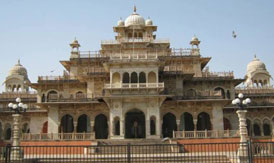 Albert Hall Museum is a museum in Jaipur city. Albert Hall is the oldest museum of the Rajasthan and functions as the State museum. The building is located in Ram Niwas Garden outside the walled city opposite New gate or Chaura Rasta. The foundation stone of Albert Hall was laid by Albert Edward The Prince of Wales on 6 February 1876 and from there only Abert Hall got its name. The building was designed by Sir Samuel Swinton Jacob and it is a fine example of Indo-Saracenic architecture. Maharaja Ram Singh initially wanted this building to be a town hall, but his successor, Madho Singh II approved it as a Museum by the suggestion of Dr. Thomas Holbein Hendley The artefacts that had been collected from several parts of India and from around the World, were merged and shifted to the Albert hall Museum. The Albert Hall was completed and was opened for public in 1887 as a museum. The museum has a rich collection of artefacts like paintings, carpets, ivory, stone, metal sculptures, colourful crystal works etc.
Albert Hall Museum is a museum in Jaipur city. Albert Hall is the oldest museum of the Rajasthan and functions as the State museum. The building is located in Ram Niwas Garden outside the walled city opposite New gate or Chaura Rasta. The foundation stone of Albert Hall was laid by Albert Edward The Prince of Wales on 6 February 1876 and from there only Abert Hall got its name. The building was designed by Sir Samuel Swinton Jacob and it is a fine example of Indo-Saracenic architecture. Maharaja Ram Singh initially wanted this building to be a town hall, but his successor, Madho Singh II approved it as a Museum by the suggestion of Dr. Thomas Holbein Hendley The artefacts that had been collected from several parts of India and from around the World, were merged and shifted to the Albert hall Museum. The Albert Hall was completed and was opened for public in 1887 as a museum. The museum has a rich collection of artefacts like paintings, carpets, ivory, stone, metal sculptures, colourful crystal works etc.
Jal Mahal
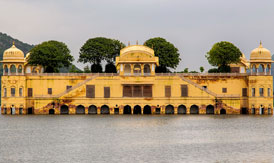 Jal Mahal is considered as one of the most beautiful architectural palace that was built with the Mughal and Rajput craftsmanship. The palace provides a charming view of the Man Sagar Lake and the Nahargarh hills that border it. The Jal Mahal palace is considered an architectural beauty built in the Rajput and Mughal styles of architecture. Jal Mahal which literally means the “Water Palace” is a palace located in the middle of the Man Sagar Lake in Jaipur city, the capital of the state of Rajasthan. The palace and the lake around it were modernized and enlarged in the 18th century by Maharaja Jai Singh II of Amber. Jal Mahal, that means water palace in English, is a beautiful place that is located in the center of the lake Man Sagar, in Jaipur.
Jal Mahal is considered as one of the most beautiful architectural palace that was built with the Mughal and Rajput craftsmanship. The palace provides a charming view of the Man Sagar Lake and the Nahargarh hills that border it. The Jal Mahal palace is considered an architectural beauty built in the Rajput and Mughal styles of architecture. Jal Mahal which literally means the “Water Palace” is a palace located in the middle of the Man Sagar Lake in Jaipur city, the capital of the state of Rajasthan. The palace and the lake around it were modernized and enlarged in the 18th century by Maharaja Jai Singh II of Amber. Jal Mahal, that means water palace in English, is a beautiful place that is located in the center of the lake Man Sagar, in Jaipur.
Diwan-e-Khas
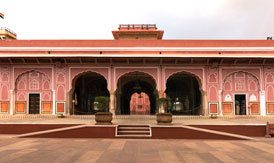 Diwan e Khas the most stunning part of the Amber Fort that completes the view of this amazing monument. The story of pink city is initiates with the wonderful medieval fort of amber, just exterior its city limits. Amber and the impearl city of jaipur made in the eighteenth century are an amazing introduction to the waste kingdoms of Rajasthan. It attracts by the romance and charm of the city. A breathtakingly stunning complex of palaces, halls, pavilions, gardens and temples standing in an outstanding state reflects the regal past of Rajasthan. The artistic ambiance of this alarming fort is seen within its walls on a four height layout plan (each with a courtyard) in a well turned luxurious palace complex made with red sandstone and marble consisting of the Diwan-e Aam or the hall of public audience, The Diwan-E-Khas or the hall of private audience.
Diwan e Khas the most stunning part of the Amber Fort that completes the view of this amazing monument. The story of pink city is initiates with the wonderful medieval fort of amber, just exterior its city limits. Amber and the impearl city of jaipur made in the eighteenth century are an amazing introduction to the waste kingdoms of Rajasthan. It attracts by the romance and charm of the city. A breathtakingly stunning complex of palaces, halls, pavilions, gardens and temples standing in an outstanding state reflects the regal past of Rajasthan. The artistic ambiance of this alarming fort is seen within its walls on a four height layout plan (each with a courtyard) in a well turned luxurious palace complex made with red sandstone and marble consisting of the Diwan-e Aam or the hall of public audience, The Diwan-E-Khas or the hall of private audience.
Royal Gaitor Tumbas
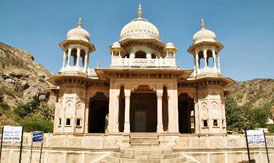 Royal Gaitor Tumbas is the cremation site of the Maharajas of Rajasthan. The site is located in Brahmpuri, 15 km from Jaipur at the foothills of Nahargarh Fort. Royal cenotaphs are built over the cremation site that is a perfect blend of Islamic and Hindu architecture. The carving on each cenotaph is a reflection of the taste of the respective Maharajas. The cenotaph of Maharaja Sawai Jai Singh II stands out and is made of white marble with intricate carvings on it. This place also offers a stunning panorama of the whole of Jaipur town including views of the Maan Sarovar Lake and the Jal Mahal Monument from here. Unlike the other tourist destinations in Jaipur, Royal Gaitor Tumbas is not crowded and is the best place to relax with friends and family. It is believed that the word Gaitor is the mispronouncation form of 'Gaye ka Thor’, a Hindi phrase that means the 'resting place of the departed souls.
Royal Gaitor Tumbas is the cremation site of the Maharajas of Rajasthan. The site is located in Brahmpuri, 15 km from Jaipur at the foothills of Nahargarh Fort. Royal cenotaphs are built over the cremation site that is a perfect blend of Islamic and Hindu architecture. The carving on each cenotaph is a reflection of the taste of the respective Maharajas. The cenotaph of Maharaja Sawai Jai Singh II stands out and is made of white marble with intricate carvings on it. This place also offers a stunning panorama of the whole of Jaipur town including views of the Maan Sarovar Lake and the Jal Mahal Monument from here. Unlike the other tourist destinations in Jaipur, Royal Gaitor Tumbas is not crowded and is the best place to relax with friends and family. It is believed that the word Gaitor is the mispronouncation form of 'Gaye ka Thor’, a Hindi phrase that means the 'resting place of the departed souls.
Khole Ke Hanuman Temple
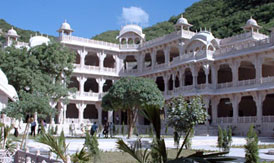 Perched near the summit of a wooded hill and approached by forested winding roads is the ancient and famous, Khole Hanuman temple of Jaipur. As our car, bound on the way to the temple, left the main road and took a detour – the sight of the enveloping mountainous landscape holding in its cup, the green rolling pathways – quickly stole my heart. Among my numerous visits to this royal city, this was the first occasion of paying my reverence in this beautiful and very peaceful 18th century temple dedicated to the monkey God Hanuman and I wondered how I missed visiting it before. Situated in the outskirts of the Jaipur city, on the Delhi bypass road, Khole Ke Hanuman temple enjoys an unprecedented fame drawing a relentless flock of devotes and loyalists all-round the year, Tuesdays and Saturdays, being the most crowded days of the week.
Perched near the summit of a wooded hill and approached by forested winding roads is the ancient and famous, Khole Hanuman temple of Jaipur. As our car, bound on the way to the temple, left the main road and took a detour – the sight of the enveloping mountainous landscape holding in its cup, the green rolling pathways – quickly stole my heart. Among my numerous visits to this royal city, this was the first occasion of paying my reverence in this beautiful and very peaceful 18th century temple dedicated to the monkey God Hanuman and I wondered how I missed visiting it before. Situated in the outskirts of the Jaipur city, on the Delhi bypass road, Khole Ke Hanuman temple enjoys an unprecedented fame drawing a relentless flock of devotes and loyalists all-round the year, Tuesdays and Saturdays, being the most crowded days of the week.